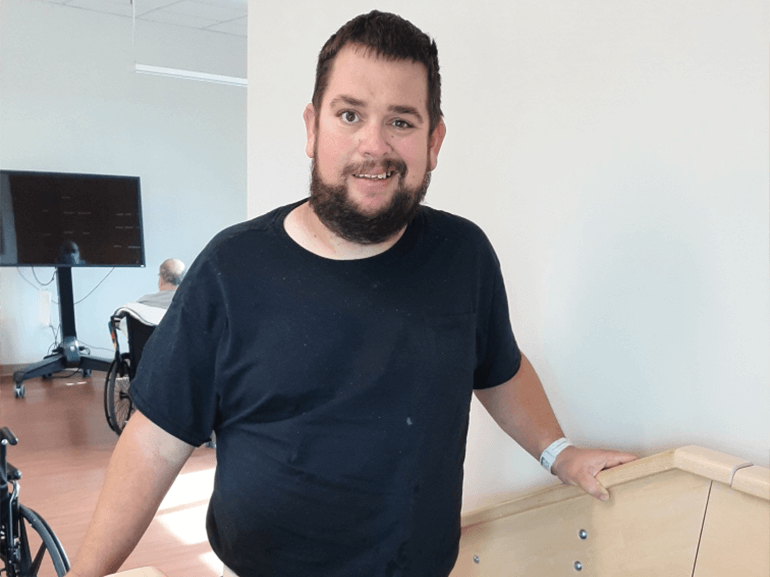Joseph's Story

Joseph “T-Joe” St. Pierre, 39, was working full time as a boat equipment inspector and enjoying fishing, crawfishing, crabbing and spending time with his wife, Jerricka, in his free time. Waking one night to get some water, he was surprised when he kept dropping his cup. He tried to say something to Jerricka, but his speech was slurred and she noticed the right side of his face was drooping. She drove him to the ED in their small Louisiana town and once there, he was immediately air lifted to Ochsner Main Campus in New Orleans. A CT scan revealed a large bleed on the left side of his brain, a type of stroke called an intracranial hemorrhage. A tube was placed in his airway to help him breathe. Eleven days later he was breathing on his own, and when medically stable, was transferred to Ochsner Rehabilitation Hospital to continue his recovery.
Upon arrival, T-Joe required minimal assistance for some tasks such as feeding himself and brushing his teeth, and maximal assistance for others such as dressing, toileting, bathing, and rolling or sitting in bed. His occupational therapy team worked with Joe on daily hygiene and dressing tasks, and he began to see progress.
T-Joe initially required maximal assistance for all aspects of mobility including getting out of bed and getting into a wheelchair. He was unable to walk and could only stand for about five to ten seconds in the parallel bars. He had right-sided weakness and decreased right-sided sensation and awareness that made it difficult to perform everyday tasks. He also struggled with dizziness and nausea that limited his activity tolerance.
T-Joe’s physical therapist focused on improving his transfers and standing in the parallel bars. T-Joe required less assistance with each session, and he soon progressed to standing with a hemiwalker, a walker used for individuals with one-sided weakness. In physical therapy, T-Joe performed seated exercises to improve the strength and control in his right leg. He also performed standing exercises such as marches, toe taps and weight shifts designed to improve his strength and balance on his right side. As he improved, he was able to graduate from the hemiwalker to a four-point cane and then to a single-point cane.
T-Joe was also experiencing difficulty swallowing from weakened muscles following his stroke, as well as general facial weakness and slurred speech. Due to his difficulty swallowing, T-Joe was initially placed on a modified diet of pureed solids with thickened liquids. His speech therapist worked with him on swallowing exercises and monitored his progress. As T-Joe’s swallowing improved, he underwent an assessment called FEES, which stands for Fiberoptic Endoscopic Evaluation of Swallowing. During a FEES, a tube with a camera on the end is inserted into the patient’s nose, which gives the speech therapist a complete view of the patient’s swallowing abilities while the patient consumes different consistencies of food and drink. The assessment revealed T-Joe was able to consume thin liquids safely, as long as he took small sips. T-Joe’s speech therapist provided him with a volume control cup to limit the size and rate of his sips. Over the next couple weeks, T-Joe’s swallowing function continued to improve and he was able to tolerate solid foods cut up into bite-sized pieces.
To improve his strength, range of motion and coordination of his speech muscles, T-Joe participated in Neuromuscular Electrical Stimulation for Swallowing (NMES) using VitalStim. NMES therapy involves electrically stimulating muscle contraction to increase strength, coordination and range of motion of the oral and facial muscles to help with speech and swallowing function. At the beginning of his stay, T-Joe’s speech was understandable less than 75 percent of the time and he had poor movement and sensation in the right side of his face. At discharge, T-Joe’s speech was understandable over 90 percent of the time, and he had significantly improved sensation, strength and coordination in the right side of his face.
T-Joe and his speech therapist worked on word finding activities, such as naming pictures of objects, naming objects from a description and describing pictures in as much detail as possible. He also completed automatic speech tasks, such as counting, saying the days of the week and saying the months of the year, to improve his verbal expression skills. To improve his receptive language skills, T-Joe completed auditory comprehension tasks, such as following multi-step directions. When T-Joe discharged, he was able to understand basic and complex information most of the time with familiar and unfamiliar conversation partners. When T-Joe was first admitted to Ochsner Rehabilitation Hospital, his goal was to improve the strength of his right leg. He far exceeded those expectations by discharge, walking independently over 800 feet with a single point cane. He was also able to stand up and go up and down 12 stairs. With T-Joe’s determination and the support of his family, he was able to safely return home and continue progressing in outpatient therapy. His dad, Joe Sr., visited him frequently, and Jerricka stayed with T-Joe throughout his time in the hospital. Jerricka actively participated in his speech therapy sessions, which enabled her to work with him to complete the exercises outside of therapy.
Since completing his stay at Ochsner Rehabilitation Hospital, T-Joe says he feels much stronger and he’s proud of his achievements. He plans to continue working on his speech and mobility through outpatient therapy. T-Joe’s advice to others in a recovery journey is: “Keep your head up and work as hard as you can in therapy."